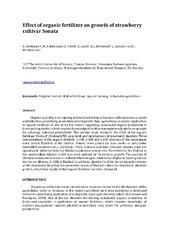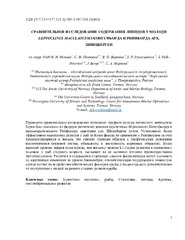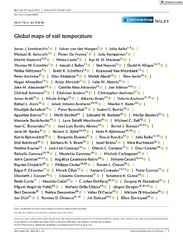Artikler, rapporter og annet (arktisk og marin biologi): Recent submissions
Now showing items 541-560 of 1643
-
Effect of organic fertilizer on growth of strawberry cultivar ‘Sonata’
(Journal article; Tidsskriftartikkel; Peer reviewed, 2021-04-28)Organic agriculture is acquiring increased attention in Armenia with numerous projects and initiatives prioritizing production of ecologically clean agricultural products. Application of organic fertilizers is one of the key factors supporting sustainable organic production of fruits and vegetables, which requires knowledge of fertilization regimes adapted to crop types for achieving optimum ... -
Large scale patches of Calanus finmarchicus and associated hydrographic conditions off the Lofoten archipelago
(Journal article; Tidsskriftartikkel; Peer reviewed, 2021-12-24)Large swarms of individuals at different spatiotemporal scales characterise the distributions of many animal species. In the ocean several mesozooplankton taxa aggregate in large patches or swarms driven by active behavioural responses to hydrographic structures, although intrinsic biotic characteristics of species´life cycles not related with the environment can also affect spatial distributions. ... -
The context of an emerging predation problem: Nenets reindeer herders and Arctic foxes in Yamal
(Journal article; Tidsskriftartikkel; Peer reviewed, 2021-05-12)Human-wildlife problems often arise when predators kill livestock. This can develop into serious conflicts between traditional pastoralists and other stakeholders, such as government officials and conservationists. In the Yamal Peninsula (Russia), nearly half of the indigenous Nenets people are reindeer herders. They have recently faced many challenges, such as high mortality of reindeer from pasture ... -
The Arctic fox (Vulpes lagopus L.) on the Kola Peninsula (Russia): silently disappearing in the mist of data deficiency?
(Journal article; Tidsskriftartikkel; Peer reviewed, 2021-04-02)The Arctic fox (Vulpes lagopus L.) population on the Kola Peninsula occupies an intermediate, and potentially connecting, position between foxes living on the Scandinavian Peninsula and populations further east in Russia, but very little is known about the status of this population. Here we summarize data from the literature, forgotten archival sources about research in the first half of the twentieth ... -
Dental evidence for variation in diet over time and space in the Arctic fox, Vulpes lagopus
(Journal article; Tidsskriftartikkel; Peer reviewed, 2021-02-16)Studies of the effects of variation in resource availability are important for understanding the ecology of high-latitude mammals. This paper examines the potential of dental evidence (tooth wear and breakage) as a proxy for diet and food choice in Vulpes lagopus, the Arctic fox. It presents a preliminary study of dental microwear, gross wear score, and tooth breakage in a sample (n = 78 individuals) ... -
Comparative Study of Lipid Content in Leptoclinus maculatus Postlarvae from Kongsfjord and Rjipfjord, Svalbard Archipelago
(Journal article; Tidsskriftartikkel; Peer reviewed, 2021-12-29)A comparative study of lipid profile of the daubed shanny <i>Leptoclinus maculatus</i> postlarvae from fjords of different domains (arctic-boreal Kongsfjord and high-arctic Rjipfjord) of Svalbard Archipelago waters in summer was performed. A more efficient accumulation of lipids in the fishes from Kongsfjord compared to Rjipfjord due to triacylglycerols and wax esters was established. These differences ... -
Strong and lasting impacts of past global warming on baleen whales and their prey
(Journal article; Tidsskriftartikkel; Peer reviewed, 2022-02-02)Global warming is affecting the population dynamics and trophic interactions across a wide range of ecosystems and habitats. Translating these real-time effects into their long-term consequences remains a challenge. The rapid and extreme warming period that occurred after the Last Glacial Maximum (LGM) during the Pleistocene–Holocene transition (7–12 thousand years ago) provides an opportunity ... -
Monitoring a changing Arctic: Recent advancements in the study of sea ice microbial communities
(Journal article; Tidsskriftartikkel; Peer reviewed, 2021-11-25)Sea ice continues to decline across many regions of the Arctic, with remaining ice becoming increasingly younger and more dynamic. These changes alter the habitats of microbial life that live within the sea ice, which support healthy functioning of the marine ecosystem and provision of resources for human-consumption, in addition to influencing biogeochemical cycles (e.g. air–sea CO<sub>2</sub> ... -
Growth rings show limited evidence for ungulates’ potential to suppress shrubs across the Arctic
(Journal article; Tidsskriftartikkel; Peer reviewed, 2022-02-22)Global warming has pronounced effects on tundra vegetation, and rising mean temperatures increase plant growth potential across the Arctic biome. Herbivores may counteract the warming impacts by reducing plant growth, but the strength of this effect may depend on prevailing regional climatic conditions. To study how ungulates interact with temperature to influence growth of tundra shrubs across ... -
Pelagic food web structure in high nutrient low chlorophyll (HNLC) and naturally iron fertilized waters in the Kerguelen Islands region, Southern Ocean
(Journal article; Tidsskriftartikkel; Peer reviewed, 2021-08-19)The Kerguelen Plateau is a region of natural iron fertilization in the Southern Ocean, within the typically iron limited High Nutrient Low Chlorophyll (HNLC) waters of the eastward flowing Antarctic Circumpolar Current. Between 26 February and 19 March 2018, the MOBYDICK expedition investigated pelagic ecosystem dynamics in the Kerguelen Island region on the northern plateau during the post-phytoplankton ... -
Arctic sea ice algae differ markedly from phytoplankton in their ecophysiological characteristics
(Journal article; Tidsskriftartikkel; Peer reviewed, 2021-05-20)Photophysiological and biochemical characteristics were investigated in natural communities of Arctic sea ice algae and phytoplankton to understand their respective responses towards variable irradiance and nutrient regimes. This study revealed large differences in photosynthetic efficiency and capacity between the 2 types of algal assemblages. Sea ice algal assemblages clearly displayed increased ... -
Phenological and elevational shifts of plants, animals and fungi under climate change in the European Alps
(Journal article; Tidsskriftartikkel; Peer reviewed, 2021-04-27)Mountain areas are biodiversity hotspots and provide a multitude of ecosystem services of irreplaceable socio-economic value. In the European Alps, air temperature has increased at a rate of about 0.36°C decade<sup>−1</sup> since 1970, leading to glacier retreat and significant snowpack reduction. Due to these rapid environmental changes, this mountainous region is undergoing marked changes in spring ... -
Taxa-specific activity loss and mortality patterns in freshwater trematode cercariae under subarctic conditions
(Journal article; Tidsskriftartikkel; Peer reviewed, 2021-11-11)Cercarial activity and survival are crucial traits for the transmission of trematodes. Temperature is particularly important, as faster depletion of limited cercarial energy reserves occurs at high temperatures. Seasonal climate conditions in high latitude regions may be challenging to complete trematode life cycle during the 6-month ice-free period, but temperature effects on the activity and ... -
Monitoring biodiversity in the Anthropocene using remote sensing in species distribution models
(Journal article; Tidsskriftartikkel; Peer reviewed, 2020-01-13)<p>In the face of the growing challenges brought about by human activities, effective planning and decision-making in biodiversity and ecosystem conservation, restoration, and sustainable development are urgently needed. Ecological models can play a key role in supporting this need and helping to safeguard the natural assets that underpin human wellbeing and support life on land and below water ... -
Why don't all species overexploit?
(Journal article; Tidsskriftartikkel; Peer reviewed, 2021-06-14)Overexploitation of natural resources is often viewed as a problem characteristic of only the human species. However, any species could evolve a capacity to overexploit its essential resources through natural selection and competition, even to the point of resource collapse. Here, we describe the processes that potentially lead to overexploitation and synthesize what is known about overexploitation ... -
Cascading effects of moth outbreaks on subarctic soil food webs
(Journal article; Tidsskriftartikkel; Peer reviewed, 2021-07-23)The increasing severity and frequency of natural disturbances requires a better understanding of their effects on all compartments of biodiversity. In Northern Fennoscandia, recent large-scale moth outbreaks have led to an abrupt change in plant communities from birch forests dominated by dwarf shrubs to grass-dominated systems. However, the indirect effects on the belowground compartment remained ... -
Environmentally modulated repeat evolution of polymorphic Arctic charr life history traits
(Journal article; Tidsskriftartikkel; Peer reviewed, 2021-12-13)Sympatric Arctic charr, <i>Salvelinus alpinus</i> (L. 1758), morphs have flexible but repeated life history strategies tested across five Norwegian lakes. In several Scandinavian polymorphic Arctic charr populations differentiated by their diet and habitat use, a large littoral omnivorous (LO) morph commonly cooccurs with a smaller profundal spawning (PB/PZ) morph. A third, large piscivorous (PP) ... -
Accounting for food web dynamics when assessing the impact of mesopredator control on declining prey populations
(Journal article; Tidsskriftartikkel; Peer reviewed, 2021-01-06)<p>1. Increasing populations of mesopredators are suspected to cause declines in vulnerable wildlife to the extent that mesopredator decimation actions (culling) have become commonplace. Design constraints, especially a lack of spatial replication, often hamper the assessment of the impact of such actions. However, extensive temporal replication (i.e. time series) and accounting for potentially ... -
Global maps of soil temperature
(Journal article; Tidsskriftartikkel; Peer reviewed, 2021-12-29)Research in global change ecology relies heavily on global climatic grids derived from estimates of air temperature in open areas at around 2 m above the ground. These climatic grids do not reflect conditions below vegetation canopies and near the ground surface, where critical ecosystem functions occur and most terrestrial species reside. Here, we provide global maps of soil temperature and bioclimatic ... -
Deepened snow enhances gross nitrogen cycling among Pan-Arctic tundra soils during both winter and summer
(Journal article; Tidsskriftartikkel; Peer reviewed, 2021-07-10)Many Arctic regions currently experience an increase in winter snowfall as a result of climate change. Deepened snow can enhance thermal insulation of the underlying soil during winter, resulting in warmer soil temperatures that promote soil microbial nitrogen (N)-cycle processes and the availability of N and other nutrients. We conducted an <i>ex situ</i> study comparing the effects of deepened ...


 English
English norsk
norsk


















